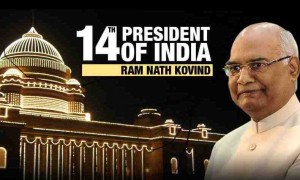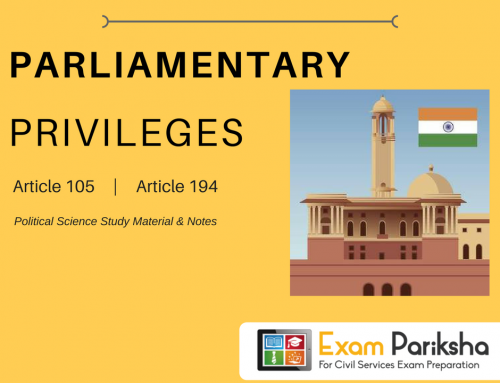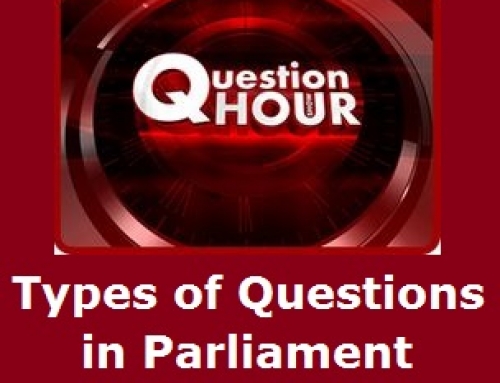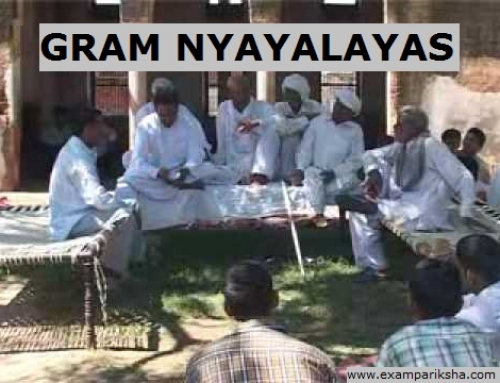The President of India is part of the Union Executive, along with the Prime Minister and his Council of Ministers.

President of India – Shri Ram Nath Kovind
Who is the current President of the Republic of India?
Ram Nath Kovind is the 14th President of India, since July 2017. Previously he had served as the Governor of Bihar from 2015 to 2017 and was a Rajya Sabha MP from 1994 to 2006.
Qualifications for President of India:
- He/she should be a citizen of India;
- should have completed the age of 35 years;
- should be qualified to be elected as a member of Lok Sabha;
- should not hold any office of profit i.e. the candidate should not be a government servant. (The office of the President, the Vice-President, the Governor or the Minister of the Union or the State is not considered as an office of profit for this purpose).
The procedure of Election of President
- The President is elected by an Electoral College -elected members of both Houses of Parliament i.e. Lok Sabha and Rajya Sabha and of the State Legislative Assemblies.
- Nominated members of Parliament and members of State Legislative Councils are not a part of the Electoral College.
- The election is held by a single transferable vote system of proportional representation.
- The voting is done by secret ballot.
- Names of all the candidates are listed on the ballot paper and the elector gives them numbers preferences. Every voter may mark on the ballot paper as many preferences as there are candidates. Thus the elector shall place the figure “1 ” opposite the name of the candidate whom he/she chooses for first preference and so on.
- To be elected, a candidate must get more than 50% of the total valid votes polled. This is known as Quota. The Quota is determined by calculating the total number of votes polled divided by the number of candidates to be elected plus one.
- In the first count, only first preference votes are counted. If any candidates reach the quota, he/she is declared elected.
- In case no candidate reaches the quota in the first round, then the 2nd preference votes of the candidate getting the least number of first preference votes are transferred to other candidates. Thus the candidate getting the least number of votes is eliminated. If after counting, a candidate reaches the quota, he/she is declared elected as the President. This continues till any one candidate gets the quota of votes.
Oath: The President has takes an oath of office in the presence of the Chief Justice of India.
Tenure: The President has a term of five years and is eligible for re-election. He/she can resign prior to the expiry of his term, or his office may fall vacant due to his/her death. For all purposes, his term of office is said to commence from the date he takes the oath of office.
Privileges of the President:
- The President is not answerable to any court of law for the exercise of his functions.
- The President can neither be arrested nor any criminal proceedings can be instituted against him in any court of law during his tenure.
- The President cannot be asked to be present in any court of law during his tenure.
- A prior notice of two months time is to be served before instituting a civil case against him.
Functions and Powers of the President:
These are divided into three heads-
- Executive powers
- Legislative powers
- Financial powers
Executive Powers of the President of India
- All decisions of the Union Government are communicated to him/her by the Prime Minister.
- All the functions are performed by the President on the advice of the Prime Minister.
- All officials appointed by him/her (such as Governors and Ambassadors) may be removed or recalled by him/her, on the advice of the Union Council of Ministers.
- All laws enacted by the Union Parliament are enforced by him/her.
- All diplomatic work is conducted in his/her name (by the foreign office and Indian envoys abroad), and all international treaties are negotiated and concluded in his/her name.
- The President appoints India’s ambassadors and high commissioners in other countries, and the President receives foreign ambassadors and high commissioners.
- The President can declare war and make peace.
- In his/her capacity as head of state, the President conducts the country’s foreign affairs.
- The President is the Supreme Commander of the armed forces. He/she makes appointments of Chiefs of Army, Navy, and Air Force.
- The President appoints the Attorney General, the Comptroller and Auditor General of India, the Chief Election Commissioner and other
Election Commissioners, the Chairman and Members of Union Public Service Commission (U.P.S.C.). - He/she also appoints the Governors of States and Lt. Governors of Union Territories. All such appointments are made on the advice of the Union Cabinet.
- The President appoints the Chief Justice and other judges of the Supreme Court and High Courts, the Chief Justice of India is consulted in these appointments.
- He allocates portfolios among the ministers on the advice of the Prime Minister. He may remove any Minister on the advice of the
Prime Minister. - The President appoints the Prime Minister and he appoints other ministers on the advice of the Prime Minister.
Legislative Powers of the President of India
- The President summons and prorogues the Houses of Parliament. He summons the Parliament at least twice a year, and the gap between two sessions cannot be more than six months.
- The President has the power to dissolve the Lok Sabha even before the expiry of its term on the recommendation of the Prime Minister.
- The President nominates twelve members to Rajya Sabha from amongst persons having special knowledge in the field of literature, science, art and social service.
- The President may also nominate two members of the Anglo-Indian community to the Lok Sabha in case that community is not adequately represented in the House.
- The President can call a joint sitting of the two Houses of Parliament in case of a disagreement between Lok Sabha and Rajya Sabha on a non-money bill.
- The President has the right to address and send messages to Parliament. The President addresses both Houses of Parliament jointly at the first session after every general election as well as the commencement of the first session every year.These addresses contain policies of the government of the day.
- Every bill passed by Parliament is sent to the President for his/her assent. The President may give his/her assent, or return it once for the reconsideration of the Parliament. If passed again the President has to give her assent.
- Without his/her assent no bill can become a law.
- The President may promulgate an ordinance when the Parliament is not in session.The ordinance so issued has the effect of a law.
- Such ordinance should be laid before both Houses of Parliament when they reassemble. If no action is taken, it automatically lapses six weeks after the commencement of the next session of Parliament.
Financial Powers of the President
- All money bills are introduced in the Lok Sabha only with the prior approval of the President.
- The President has the control over Contingency Fund of India. It enables the government to advance money for the purpose of meeting unforeseen expenses.
- Contingency Fund of India: It is a fund kept by the Union Government to meet any unforeseen expenditure for which money is immediately needed. The President has full control over this Fund. The President permits withdrawals from this Fund.
- Annual budget and railway budget are introduced in the Lok Sabha on the recommendation of the President.
- Money bills are never returned for reconsideration.
- The President appoints the Finance Commission after every five years. It makes recommendations to the President on some specific financial matters, especially the distribution of Central taxes between the Union and the States.
- The President also receives the reports of the Comptroller and Auditor-General of India and has it laid in the Parliament.
Miscellaneous powers:
- The President, as head of state, can pardon a criminal or reduce the punishment or suspend, commute or remit the sentence of a criminal convicted by the Supreme Court or High Courts for an offence against the federal laws.
- The President can also pardon a person convicted by a Court Martial. His/her power of pardon includes granting of pardon even to a person awarded death sentence. But, the President performs this function on the advice of Law Ministry.
Removal of the President:
It is done by impeachment, a quasi-judicial procedure, on the grounds of the violation of the Constitution.The President can be removed through impeachment. The Constitution lays down a difficult procedure for the impeachment of the President. He can only be impeached ‘for violation of the Constitution’.
The procedure of impeachment of President of India:
- The resolution to impeach the President can be moved in either House of Parliament after a notice has been given by at least one-fourth of the total number of members of the House.
- Such resolution must be passed by a majority of not less than two-thirds of the total membership of that House before it goes to the other House for investigation.
- The charges levelled against the President are investigated by the second House.
- President has right to be heard or defended when the charges against him are being investigated. He may defend himself in person or through his counsel.
- If charges accepted by two-thirds majority of the second House, the President stands removed from the office from the date of resolution passage.
Vacancy of the Presidential office:
If the office of the President falls vacant either due to death or resignation or impeachment, the Vice-President officiates it for a period, not more than six months.
The Constitution makes it obligatory that in case of vacancy of President’s office, the election must be held within six months. The newly elected President then holds office for five years.
The above discussion about the responsibilities, powers of the President suggest that the Office of Head of State is very important for upholding the constitution of India. Share your insights and suggest improvements on this in the comments below.





